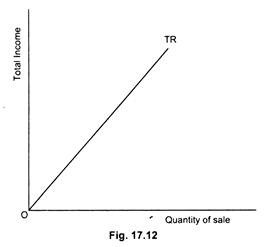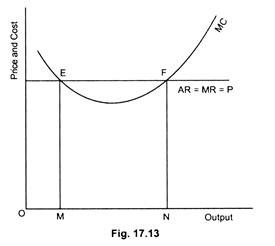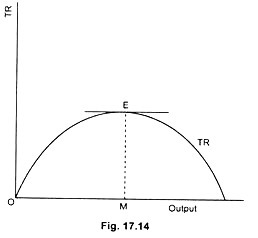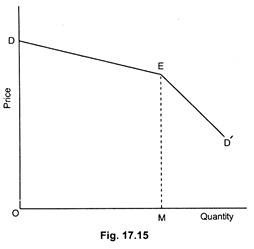Read this article to learn about the most frequently asked questions on Price Determination in Perfect and Imperfect Competition.
Q.1. Clearly state what do you mean by ‘market’ in economics.
Ans. In economics, market does not refer to a place. A market is an institution where buyers and sellers meet together to carry out their transactions i.e., purchase and sale of a commodity or an input.
Q.2. Define total revenue (TR), average revenue (AR), and marginal revenue (MR).
ADVERTISEMENTS:
Ans. Total revenue (TR) is the receipt that a firm earns from selling various amounts of its product at a given price. Thus, TR is the price per unit (p) multiplied by the number of goods sold (q). That is,
TR = p × q
Average revenue is the income which a firm earns from the sale of goods. That is,
AR = TR/q,
ADVERTISEMENTS:
Marginal revenue is the change in total revenue resulting from a change in the number of goods sold or output. In fact, MR is the revenue earned for one unit of output or goods sold. So,
MR = ∆TR/∆q,
∆TR/∆q = change in total revenue/change in number of goods sold
Q.3. Under what condition demand curve, AR curve and price line are the same?
ADVERTISEMENTS:
Ans. Irrespective of the market situation, demand curve or AR curve and price line are same. AR is obtained by dividing total revenue by the total output sold. Total revenue is the price per unit of output multiplied by the number of units of output sold.
Suppose, a seller sells 10 units of a goods at the rate of Rs. 5 per unit. Thus, total revenue is Rs. 50. Now by dividing total revenue by output we get AR. Thus, by definition, AR and price are identical. And, this AR curve is the demand curve which shows various quantities of a commodity that can be bought at various price. Thus, AR = P = Demand.
Q.4. Is the MR curve identical with the AR curve for an individual firm under perfect competition?
Or
What is the shape of the AR curve in a perfectly competitive market?
Ans. Under perfect competition, every buyer and seller behaves as a price-taker. That is why price and AR are identical. As in a competitive firm price remains the same, AR also remains unchanged. By MR we mean change in revenue resulting from a change in output. Thus, AR coincides with MR, i.e., AR = MR.
Q.5. When will the average revenue and marginal revenue be different?
Ans. Under imperfect competition, since a seller can influence the price of a product, both average revenue and marginal revenue curves become downward sloping, but average revenue becomes greater than marginal revenue. In other words, under imperfect competition, AR curve lies above the MR curve, i.e., AR > MR.
Q.6. Suppose the average revenue curve of a firm is a horizontal straight line. Draw a total revenue curve in this situation.
ADVERTISEMENTS:
Ans. Under perfect competition as sellers behave as ‘price-takers’, they cannot influence the price. At a given price, sellers can sell any amount as they like. In such a situation, total revenue rises proportionately with the increase in sales. This means that TR curve is a straight line rising curve starting from the origin, shown in Fig. 17.12.
Q.7. Mention the conditions of equilibrium of a firm.
Or
ADVERTISEMENTS:
What are the conditions of profit maximisation of a firm?
Ans. Irrespective of the market conditions, a firm will be in equilibrium if two conditions are simultaneously fulfilled. First is the equality between MC and MR. This condition is known as necessary condition. Second is that MC curve must cut the MR curve from below. This condition is known as sufficient condition.
Q.8. What are the features of perfect competition?
Or
ADVERTISEMENTS:
Write down four characteristics of perfect competition.
Ans. A product market is said to be a perfectly competitive one if the following conditions are fulfilled:
(a) There exists innumerable number of sellers and buyers,
(b) Sellers behave as ‘price-takers’. Buyers also cannot influence the price ruling in the market. Consequently, AR curve = price line becomes perfectly elastic,
(c) Sellers sell homogeneous goods,
(d) In the long run, there is perfect freedom of entry and exist, and
ADVERTISEMENTS:
(e) Factors of production are perfectly mobile.
Q.9. Why would a firm under pure competition never want to spend any money on advertisement for his product?
Ans. Under pure competition, sellers sell homogeneous goods. This means that to the buyers all the available goods in the market are perfect substitutes. Naturally, sellers are not willing to spend on advertisement for his product to buyers.
Q. 10. Why does a firm in pure competition operate in the rising portion of its MC curve?
Ans. A firm under perfect competition, in order to maximise profit, operates at the rising portion of its MC curve. In terms of figure (17.13), a firm should operate at point F, rather than E where MC curve is falling. At E, profit can never be maximum by producing OM output.
If a firm decides to raise output (up to ON) its revenue will increase than its cost. So a producer determines its output level at the rising portion of its MC curve.
Q.11. Is it possible for a competitive firm to earn supernormal profit or sustain loss in the long run?
Ans. In the long run, a competitive firm enjoys only normal profit, because of free entry and free exit of firms in the industry. If some firms earn supernormal profit, other firms will join the industry and pull down the volume of supernormal profit. Similarly, sustenance of loss by some firms will cause them to leave the industry and, ultimately, loss will be eliminated.
Q. 12. Is it correct to say that in the short run a profit-maximising firm under perfect competition may produce under a loss?
Ans. In the short run, a perfectly competitive firm faces two types of cost—fixed cost and variable cost. If the firm fails to cover not only fixed cost but also a part of the variable cost, it will shut down the business. But, if it covers up just the variable cost still then it will continue business with the hope of managing a part of the fixed cost in the near future.
Q.13. What is a shutdown point?
Ans. If the price of the product of a competitive firm is just equal to the minimum average variable cost (AVC), the firm reaches shutdown point. When price becomes equal to minimum AVC, the firm covers up its variable cost only. So, when price = minimum AVC, the shutdown point emerges.
ADVERTISEMENTS:
Q. 14. Where does a competitive firm’s breakeven point occur?
Ans. Breakeven point is that point where price of a product of a competitive firm becomes equal to minimum AC. This amounts to saying that the firm covers up total cost (both fixed cost and variable cost) including normal profit. So, at the breakeven point price or AR becomes equal to minimum AC.
Q.15. You know demand curves are negatively sloped. Then how do you reconcile it with horizontal demand curve under perfect competition?
Ans. Negative sloping demand curve shows how the consumers demand larger (or smaller) quantities of a commodity at a lower (or high) prices. The market price is the result of the demand and supply of the commodity in the market or the industry.
Once this price is determined, a competitive firm has to accept this price since the competitive firm behaves as a price-taker. A price- taker can sell any amount at the ruling price. That is why the demand curve faced by a competitive firm is a horizontal straight line.
Q. 16. How is the short run supply curve of a competitive firm obtained?
ADVERTISEMENTS:
Ans. Short run MC curve that lies above the AVC curve is called the short run supply curve of a competitive firm.
Q.17. Is it possible to derive the long run supply curve of a competitive industry from the long run MC curves of all firms?
Ans. In the long run, the supply curve of a competitive industry cannot be obtained by summing up the short run MC curves of firms. The shape of a supply curve in the long run is governed by the laws of production or cost conditions.
If production is subject to the law of constant cost, the supply curve of an industry will be a straight line parallel to the horizontal axis, If increasing costs operate, the supply curve would be upward rising and downward sloping in the case of diminishing costs.
Q. 18. When does a market become competitive and when it becomes imperfectly competitive?
Ans. A competitive firm is characterised by:
(i) Innumerable number of sellers,
(ii) Homogeneous goods;
(iii) Given price, and
(iv) Free entry and exit.
If one of these features are absent the market becomes imperfectly competitive which has different variants, like monopoly, monopolistic competition and oligopoly.
Q. 19. What is the shape of the total revenue curve under monopoly?
Ans. Under imperfect competition or monopoly, if a firm intends to sell more it will have to cut down price.
As price declines TR rises following an increase in sales. However, TR becomes maximum at a particular level of output sold.
After that, TR declines and it reduces to zero (see Fig. 17.14).
Q.20. Why does not a monopoly producer operate at the inelastic range of his demand curve?
Ans. In the inelastic range of the demand curve, marginal revenue becomes negative. We know that marginal cost is always positive. As negative marginal revenue cannot be equated with the positive marginal cost, a monopolist does not operate at the inelastic range of his demand curve. Only at the elastic range of the demand curve marginal revenue is positive where he produces.
Q.21. What is the basic difference between the equilibrium of a competitive firm and monopoly firm?
Ans. A competitive firm will be in equilibrium when MC = MR = AR. But, as monopolist’s MR curve lies below the AR curve, he will be in equilibrium when MC = MR < AR.
Q.22. What is meant by price discrimination by a monopolist?
Ans. Price discrimination is said to exist when sellers charge different prices to different buyers for his product. Price discrimination is possible under monopoly since a monopolist pursues an independent price policy.
Q.23. When is price discrimination profitable?
Ans. Price discrimination will be profitable if two conditions are fulfilled.
These are:
(a) Elasticities of demand for a product at a given monopoly price must be different in different markets; and
(b) Marginal revenues in all markets must be the same.
Q.24. Could you discriminate between buyers while selling a product under perfect competition?
Ans. Price discrimination is impossible under perfect competition since sellers behave as price-takers. Buyers also know the price of the product ruling in the market. Neither buyer nor seller can influence the price in any direction. Price discrimination is only possible under monopoly where a monopoly seller behaves as the price-setter.
Q.25. What is monopolistic competition?
Ans. Monopolistic competition is an admixture of both perfect competition and monopoly. Here large number of sellers sell differentiated goods. Sellers also behave as price- makers.
Q.26. What is oligopoly?
Ans. An oligopoly market is said to exist where the number of sellers is very few. Price rigidity is one of the characteristics of the oligopoly market.
Q.27. The monopolistically competitive firm may engage in non-price competition. Give two instances of such non-price competition.
Ans. Product variation and selling costs are two important forms of non-price competition. According to Chamberlin, in monopolistic competition, sellers adopt non-aggressive price policies. They compete with each other just by varying the product and by altering the magnitude of selling costs than by changing prices.
Q.28. Why is monopoly price greater than marginal revenue under monopoly?
Ans. Under monopoly, if the seller wants to sell a larger quantity he will have to lower down the price of his product. As a result, average revenue declines. As average revenue declines marginal revenue must decline and marginal revenue becomes less than average revenue or price (MR < AR = P).
Q.29. Why does a monopolistically competitive producer fail to operate at the minimum point of his AC curve? What is its economic significance?
Ans. A monopolistically competitive firm faces a downward sloping demand curve which can never be tangential to the AC curve at its minimum point. Because of the nature of demand curve, the firm must operate somewhere to the left of the minimum point of the AC curve.
Operation in this range of AC curve implies that the firm fails to operate at optimum stage. An excess capacity develops resulting in a smaller output than perfectly competitive output and higher prices than competitive prices.
Q.30. What are the competitive elements and monopoly elements of monopolistic competition?
Ans. Competitive elements of monopolistic competition are:
(a) Existence of many competing firms;
(b) Free entry and exit in the long run;
(c) P = AC in the long run;
(d) Occurrence of only normal profit in the long run and supernormal profit, loss as well as normal profit in the short run.
Monopoly elements are the following:
(a) Negative sloping AR and MR curves;
(b) Equilibrium is attained when MC = MR < AR;
(c) Existence of monopoly of a producer due to differentiated products;
(d) Higher price and smaller output; (h) excess capacity.
Q.31. Why, instead of industry, is the word ‘group’ used in monopolistic competition?
Ans. Industry refers to a collection of firms that produce homogeneous goods. But under monopolistic competition we have product heterogeneity. That is why Chamberlin preferred the word ‘group’ instead of industry. By ‘group’, he meant number of sellers whose goods are close substitutes.
Q.32. Why are selling costs or advertisement costs incurred in a monopolistically competitive market?
Ans. In a monopolistic competitive market, sellers sell heterogeneous goods. These goods are treated as close substitutes to each other, but not perfect substitutes. That is why; sellers in order to attract customers to their own products spend money for advertisement. This advertisement cost is regarded as a part of the selling cost.
Q.33. Why is price higher under monopolistic competition?
Ans. Under monopoly or monopolistic competition, AR diverges from MR and AR curve lies above MR curve. But, in perfect competition AR curve coincides with MR curve. That is why price is higher in monopoly or monopolistic competition than under perfect competition.
Q.34. Will a competitive producer, monopoly producer and monopolistically competitive producer earn supernormal profit in the long run?
Ans. Because of free entry, a competitive firm in the long run never earns supernormal profit. It earns only normal profit. That is why P = AR = MR = MC. Similarly, a monopolistically competitive producer also enjoys normal profit on the same ground i.e., free entry and free exit.
Though P < MR, still then a monopolistically competitive producer earns normal profit in the long run. On the other hand, entry of new firms is blocked under monopoly.
Q.35. Draw a kinked demand curve and show that price is inflexible in the oligopoly market.
Ans. Under oligopoly, demand curve is kinked at the ruling market price. If a seller cuts the price of his product, other sellers will follow him. That is why, in the range ED’, demand curve is inelastic (Fig. 17.15). On the other hand, if a seller increases the price of his product, other sellers will not follow him.
That is why, in the range DE, demand curve is elastic. As price in this market remains unchanged, demand curve is kinked at the price ME.
Q.36. What is the absolute value of the price elasticity of demand, when marginal revenue is zero?
Ans. The absolute value of the price elasticity is unity when marginal revenue becomes zero and total revenue becomes maximum.



